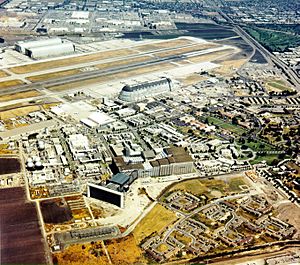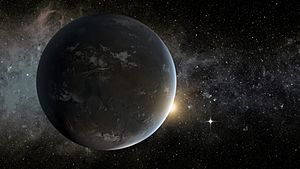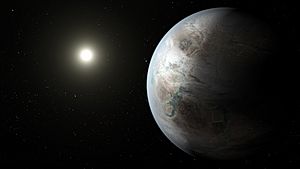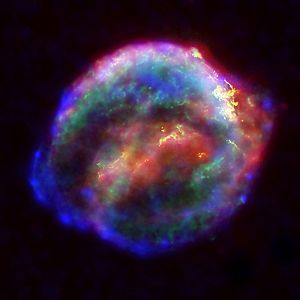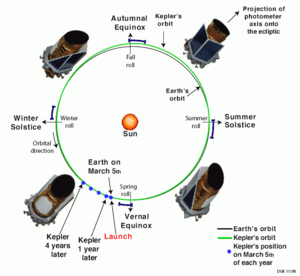Kepler (spacecraft) facts for kids

Artist's impression of the Kepler telescope
|
|
| Mission type | Space telescope |
|---|---|
| Operator | NASA / LASP |
| Mission duration | Planned: 3.5 years Final: 9 years, 7 months, 23 days |
| Spacecraft properties | |
| Manufacturer | Ball Aerospace & Technologies |
| Launch mass | 1,052.4 kg (2,320 lb) |
| Dry mass | 1,040.7 kg (2,294 lb) |
| Payload mass | 478 kg (1,054 lb) |
| Dimensions | 4.7 m × 2.7 m (15.4 ft × 8.9 ft) |
| Power | 1100 watts |
| Start of mission | |
| Launch date | March 7, 2009, 03:49:57 UTC |
| Rocket | Delta II (7925-10L) |
| Launch site | Cape Canaveral SLC-17B |
| Contractor | United Launch Alliance |
| Entered service | May 12, 2009, 09:01 UTC |
| End of mission | |
| Deactivated | November 15, 2018 |
| Orbital parameters | |
| Reference system | Heliocentric |
| Regime | Earth-trailing |
| Semi-major axis | 1.0133 AU |
| Eccentricity | 0.036116 |
| Perihelion | 0.97671 AU |
| Aphelion | 1.0499 AU |
| Inclination | 0.44747 degrees |
| Period | 372.57 days |
| Argument of perihelion | 294.04 degrees |
| Mean anomaly | 311.67 degrees |
| Mean motion | 0.96626 deg/day |
| Epoch | January 1, 2018 (J2000: 2458119.5) |
| Main telescope | |
| Type | Schmidt |
| Diameter | 0.95 m (3.1 ft) |
| Collecting area | 0.708 m2 (7.62 sq ft) |
| Wavelengths | 430–890 nm |
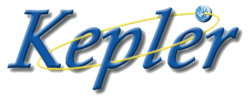
|
|
The Kepler space telescope was a special telescope launched by NASA. Its main job was to find planets similar to Earth that orbit other stars. These planets are called exoplanets.
The telescope was named after a famous astronomer, Johannes Kepler. It was launched on March 7, 2009. Kepler orbited the Sun, following behind Earth. This type of orbit is called a heliocentric orbit.
Kepler's mission lasted for over nine years. It was designed to look at a part of our own Milky Way galaxy. Scientists wanted to find Earth-sized exoplanets that might be in a "habitable zone". This is an area around a star where conditions might be right for liquid water, which is important for life. Kepler also helped scientists guess how many stars in the Milky Way might have such planets.
Kepler's only science tool was a photometer. This device constantly watched the brightness of about 150,000 stars. When an exoplanet passes in front of its star, it causes a tiny dip in the star's brightness. This is called the transit method. Kepler sent this data back to Earth. Scientists then analyzed the data to find these tiny dips, which showed them where exoplanets were. Kepler could only find planets whose orbits were seen edge-on from Earth. During its mission, Kepler looked at 530,506 stars and found 2,662 planets.
Kepler's Story
The Kepler space telescope was part of NASA's Discovery Program. This program focuses on science missions that cost less money. NASA's Jet Propulsion Laboratory managed the building and first steps of the telescope's mission. Ball Aerospace built the Kepler spacecraft itself.
The Ames Research Center helped develop the ground systems. They also managed the mission's daily operations starting in December 2009. This center was also in charge of analyzing all the science data Kepler collected.
Kepler was supposed to work for 3.5 years. However, there was more "noise" in the data than expected. This noise came from both the stars and the spacecraft itself. Because of this, more time was needed to complete all the mission's goals.
In 2012, NASA planned to extend the mission until 2016. But on July 14, 2012, one of Kepler's four reaction wheels stopped working. These wheels help the spacecraft point accurately. If the other wheels stayed reliable, the mission could continue.
Then, on May 11, 2013, a second reaction wheel failed. This meant Kepler could no longer collect science data properly. It looked like the mission might have to end.
On August 15, 2013, NASA announced they couldn't fix the two broken reaction wheels. This meant the original mission had to change. But it didn't mean the end of finding planets! NASA asked scientists to suggest new ways to use Kepler.
On November 18, 2013, a new idea called "K2" or "Second Light" was suggested. This plan would use the disabled Kepler in a new way. It could help find habitable planets around smaller, dimmer stars called red dwarfs. NASA approved the K2 extension on May 16, 2014.
By January 2015, Kepler had found 1,013 confirmed exoplanets. These planets were in about 440 star systems. There were also 3,199 other possible planet candidates. Four planets were confirmed through Kepler's K2 mission.
In November 2013, scientists used Kepler's data to make an estimate. They thought there could be as many as 40 billion rocky, Earth-sized exoplanets. These planets might be in the habitable zones of stars like our Sun or red dwarfs in the Milky Way. About 11 billion of these planets might orbit Sun-like stars. Scientists believe the closest such planet could be about 12 light-years away.
On January 6, 2015, NASA announced Kepler's 1,000th confirmed exoplanet discovery. Four of these new exoplanets were in habitable zones. Three of them, Kepler-438b, Kepler-442b, and Kepler-452b, are almost Earth-sized and likely rocky. The fourth, Kepler-440b, is a super-Earth (a planet bigger than Earth but smaller than Neptune). On May 10, 2016, NASA confirmed 1,284 new exoplanets found by Kepler. This was the largest single discovery of planets at that time.
Kepler's data also helped scientists study supernovae. These are huge star explosions. Kepler collected measurements every half-hour. This detailed data was very useful for understanding these powerful events.
On October 30, 2018, Kepler ran out of fuel. NASA announced that the telescope would be retired. It was shut down the same day, ending its nine years of service. Over its lifetime, Kepler observed 530,506 stars and discovered 2,662 exoplanets. A newer NASA mission, TESS, launched in 2018, is now continuing the search for exoplanets.
How Kepler Worked
Kepler was operated from Boulder, Colorado. The Laboratory for Atmospheric and Space Physics (LASP) managed it under a contract with Ball Aerospace & Technologies. Kepler's solar panels were turned to face the Sun during the solstices and equinoxes. This helped get the most sunlight for power. It also kept the heat radiator pointed towards deep space to keep the telescope cool.
LASP and Ball Aerospace controlled the spacecraft from a mission operations center. This center was located at the University of Colorado. LASP handled important mission planning. They also collected and shared the science data. The mission's first cost was about $600 million, which included 3.5 years of operation. In 2012, NASA decided to fund the Kepler mission until 2016, at a cost of about $20 million per year.
Kepler's Goals
The main scientific goal of Kepler was to learn about different types of planetary systems. By watching many stars, the spacecraft aimed to achieve several key things:
- To find out how many Earth-sized planets (and larger ones) exist. They wanted to see how many are in or near the "habitable zone" of different kinds of stars. These are sometimes called "Goldilocks planets."
- To learn about the different sizes and shapes of these planets' orbits.
- To estimate how many planets are found in systems with more than one star.
- To figure out the sizes, brightness, and densities of large planets that orbit their stars quickly.
- To find other planets in systems where one planet was already discovered, using different methods.
- To understand the features of stars that have planets orbiting them.
Images for kids
-
Diagram of Kepler's investigated area with celestial coordinates
-
A photo taken by Kepler with two points of interest outlined. Celestial north is towards the lower left corner.
-
Detail of Kepler's image of the investigated area showing open star cluster NGC 6791. Celestial north is towards the lower left corner.
-
Detail of Kepler's image of the investigated area. The location of TrES-2b within this image is shown. Celestial north is towards the lower left corner.
-
Kepler observed KSN 2011b, a Type Ia supernova, in the process of exploding: before, during and after.
-
Confirmed small exoplanets in habitable zones (Kepler-62e, Kepler-62f, Kepler-186f, Kepler-296e, Kepler-296f, Kepler-438b, Kepler-440b, Kepler-442b).
See also
 In Spanish: Kepler (telescopio espacial) para niños
In Spanish: Kepler (telescopio espacial) para niños


